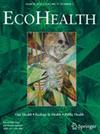没有证据表明巴西东北部的野生狨猴(Callithrix jacchus)接触过狂犬病。
IF 2.2
3区 环境科学与生态学
Q3 ENVIRONMENTAL SCIENCES
引用次数: 0
摘要
野生动物传播的狂犬病是拉丁美洲人类狂犬病死亡的主要来源,被认为是一种新出现的疾病。巴西的普通狨猴(Callithrix jacchus)是全球唯一已知的狂犬病灵长类动物贮藏地。我们在东北部四个州(伯南布哥州和巴伊亚州)检测了自由放养的活狨猴是否暴露于狂犬病,这四个州以前曾报告过狂犬病阳性的狨猴尸体(帕拉伊巴州和北里奥格兰德州)。我们的研究结果表明,在采样的狨猴中没有狂犬病抗体或感染的证据,这表明表面上健康的狨猴在其自然分布范围内并未广泛接触狂犬病。本文章由计算机程序翻译,如有差异,请以英文原文为准。
No Evidence of Rabies Exposure in Wild Marmosets (Callithrix jacchus) of Northeast Brazil.
Rabies transmitted by wildlife is the main source of human rabies mortality in Latin America and considered an emerging disease. The common marmoset Callithrix jacchus of Brazil is the only known primate reservoir of rabies worldwide. We tested whether alive free-ranging C. jacchus were exposed to rabies in four northeast states that have previously reported rabies-positive dead C. jacchus (Pernambuco and Bahia) or not (Paraíba and Rio Grande do Norte). Our results show no evidence of rabies antibodies or infection in the sampled C. jacchus, suggesting that apparently healthy marmosets are not widely exposed to rabies over their natural range.
求助全文
通过发布文献求助,成功后即可免费获取论文全文。
去求助
来源期刊

Ecohealth
环境科学-环境科学
CiteScore
4.50
自引率
4.00%
发文量
45
审稿时长
>24 weeks
期刊介绍:
EcoHealth aims to advance research, practice, and knowledge integration at the interface of ecology and health by publishing high quality research and review articles that address and profile new ideas, developments, and programs. The journal’s scope encompasses research that integrates concepts and theory from many fields of scholarship (including ecological, social and health sciences, and the humanities) and draws upon multiple types of knowledge, including those of relevance to practice and policy. Papers address integrated ecology and health challenges arising in public health, human and veterinary medicine, conservation and ecosystem management, rural and urban development and planning, and other fields that address the social-ecological context of health. The journal is a central platform for fulfilling the mission of the EcoHealth Alliance to strive for sustainable health of people, domestic animals, wildlife, and ecosystems by promoting discovery, understanding, and transdisciplinarity.
The journal invites substantial contributions in the following areas:
One Health and Conservation Medicine
o Integrated research on health of humans, wildlife, livestock and ecosystems
o Research and policy in ecology, public health, and agricultural sustainability
o Emerging infectious diseases affecting people, wildlife, domestic animals, and plants
o Research and practice linking human and animal health and/or social-ecological systems
o Anthropogenic environmental change and drivers of disease emergence in humans, wildlife, livestock and ecosystems
o Health of humans and animals in relation to terrestrial, freshwater, and marine ecosystems
Ecosystem Approaches to Health
o Systems thinking and social-ecological systems in relation to health
o Transdiiplinary approaches to health, ecosystems and society.
 求助内容:
求助内容: 应助结果提醒方式:
应助结果提醒方式:


